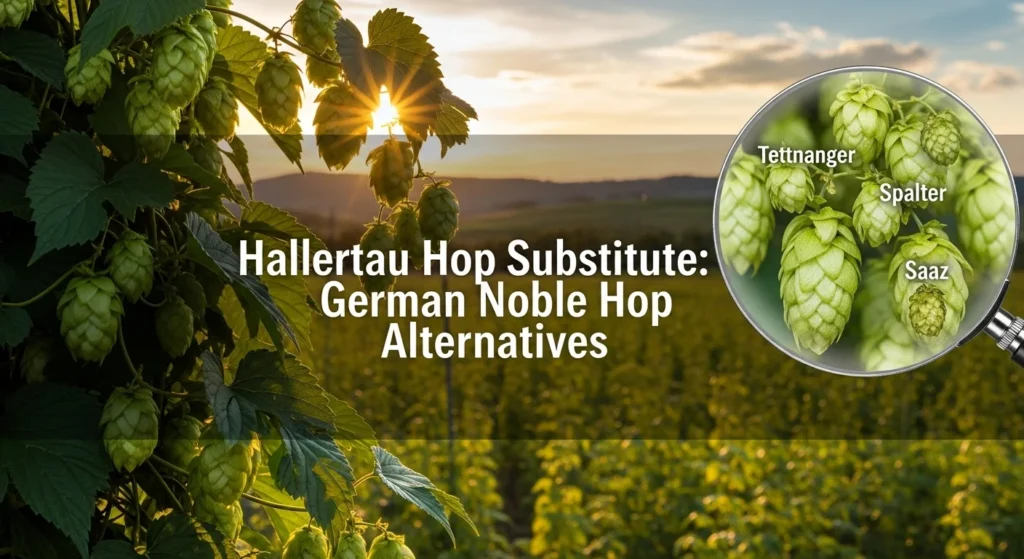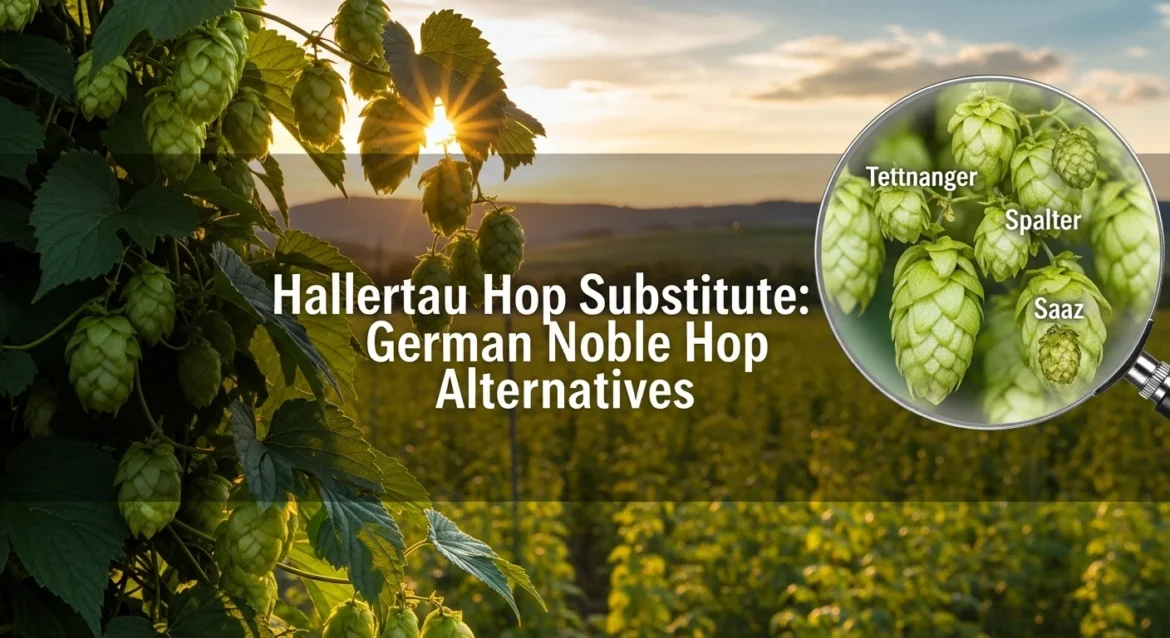Discover the best Hallertau hop substitute for authentic German lager character – find 7 noble alternatives that deliver spicy, floral flavor in 2025.

Planning a traditional German pilsner around Hallertau Mittelfrüh only to discover it’s sold out everywhere? I’ve faced this frustration countless times over my years judging international beer competitions and brewing authentic German-style lagers. This legendary noble variety’s distinctive spicy-floral character seems irreplaceable until you understand which alternatives actually deliver similar results when using home brewing equipment.
Finding the right Hallertau hop substitute matters because this traditional German noble hop brings exceptional refined character – delicate floral notes, mild spice, and subtle herbal aromatics – with low alpha acids (3.5-5.5%) perfect for pilsners, helles, and traditional European lagers.
I’ve tested every suggested Hallertau alternative across German pilsners, Belgian ales, and traditional lagers to understand how different hops perform when you’re chasing that distinctive combination of refined noble elegance with approachable traditional character. Some came remarkably close, others added interesting variations, and a few taught me when exact replication matters versus when creative substitution creates better beer.
This guide breaks down seven proven substitutes based on real brewing experience across four continents, complete with hop pairing strategies, usage recommendations, and style-specific guidance so you’re never stuck scrambling on brew day.
Understanding Hallertau Hop Character Profile
Hallertau Mittelfrüh delivers refined German aromatics with delicate notes of floral spice, mild herbal undertones, and gentle earthy character that make it one of the four traditional noble hop varieties. Originally the major Hallertau landrace variety, this hop represents authentic Bavarian brewing heritage.
The alpha acid content ranges from 3.5-5.5%, positioning Hallertau as an aroma-focused noble hop best suited for flavor and aroma applications. According to Untappd’s noble hop guide, Hallertauer Mittelfrüher is distinguished by intense, pleasantly harmonic bitterness.
What I love about Hallertau is its refined complexity without aggressive hop presence. You get clean noble elegance with subtle spice and floral notes that work beautifully in German pilsners, traditional lagers, and Belgian ales where hop character should complement rather than dominate delicate malt profiles.
The flavor profile combines gentle florals with earthy spice. According to Yakima Valley Hops, Hallertau Mittelfrüh provides one of the most elegant and refined spicy hop characteristics available in brewing.
When formulating a Hallertau hop substitute strategy, I focus on three elements: the delicate floral-spicy base, noble hop refinement, and clean finishing character that creates authentic German complexity without harsh bitterness.
Direct Single-Hop Replacements
Liberty: American Noble Heritage
Liberty provides the most commonly suggested substitution with similar alpha acids (3-5%) being specifically bred to replicate Hallertau Mittelfrüh characteristics. This American variety offers the closest match to traditional German noble character.
The key difference is Liberty’s slightly more pronounced spice versus Hallertau’s balanced floral-earthy profile. When substituting, expect very similar noble character with American-grown consistency and reliable availability.
Usage adjustment: Direct 1:1 substitution for most applications
Best applications: Lagers, pilsners, Belgian ales, wheat beers
German Tradition: Modern Noble Replacement
Hallertau Tradition delivers refined German character at 5-7% alpha acids being bred specifically to replace traditional Hallertau varieties. According to Beer Maverick, Tradition substitutes excellently for Hallertau Mittelfrüh.
I’ve found Tradition particularly effective in authentic German lagers where you want noble hop character. This variety maintains traditional profile while offering improved disease resistance and higher yields.
Substitution ratio: Use at similar or slightly reduced quantities
Ideal styles: German pilsner, helles, märzen, lager
Ultra: American Noble Alternative
Ultra brings mild noble character at 2-4.5% alpha acids with floral, spicy aromatics. This American-bred variety descends from Hallertau genetics offering compatible noble characteristics.
Flavor profile: Floral, spicy, herbal, noble elegance
Best usage: Late additions, German-style lagers
German Hop Family Alternatives
Hersbrucker: Traditional German Noble
Hersbrucker delivers classic German noble character at 3-5.5% alpha acids with delicate floral and herbal notes. According to Brew Your Own Magazine, Hersbrucker substitutes well for Hallertau in traditional brewing.
Usage notes: Direct 1:1 replacement in most applications
Applications: Pilsner, lager, wheat beer, Belgian ale
Tettnang: Refined Noble Spice
Tettnang offers delicate spicy-floral character at 3.5-5.5% alpha acids being another traditional German noble variety. While slightly different from Hallertau, Tettnang provides compatible noble character.
Substitution ratio: 1:1 for most applications
Best styles: Wheat beer, pilsner, Belgian ale, lager
Spalter: Traditional Bavarian Noble
Spalter brings classic German noble character at 2.5-5.5% alpha acids with refined spicy-herbal aromatics. This traditional variety offers authentic German character compatible with Hallertau’s profile.
Flavor profile: Spicy, herbal, earthy, noble refinement
Usage: Late additions, traditional German styles
Strategic Hop Combination Blends
The Noble Blend: Liberty + Tettnang
Combining 60% Liberty with 40% Tettnang creates a substitute capturing Hallertau’s noble base while adding complex spice layers. This duo works brilliantly in pilsners and traditional lagers where refined hop character defines the style.
The Liberty provides clean noble elegance while Tettnang contributes delicate spice complexity. Together they approximate Hallertau’s profile while maintaining authentic German tradition.
Usage rates:
- Late additions: 1-1.5 oz total per 5 gallons
- Dry hop: 0.5-1 oz total per 5 gallons (if applicable)
The German Tradition Approach: Hallertau Tradition + Hersbrucker
For authentic German brewing, try 60% Hallertau Tradition and 40% Hersbrucker. This combination provides traditional noble character with reliable modern German-grown consistency.
| Hop Combination | Ratio | Flavor Focus | Best Beer Styles |
|---|---|---|---|
| Liberty + Tettnang | 3:2 | American-German noble | Pilsner, lager |
| Tradition + Hersbrucker | 3:2 | Modern German noble | Helles, pilsner |
| Liberty + Ultra | 2:1 | Clean American noble | Belgian ale, lager |
| Tettnang + Spalter | 1:1 | Traditional German | Wheat beer, märzen |
Style-Specific Substitution Strategies
German Pilsners and Pils
Liberty or Hallertau Tradition work best for pilsners where you want refined noble hop character supporting crisp Pilsner malt. Use 1.5-2.5 oz per 5 gallons across multiple late additions for optimal noble expression.
For authentic German pils, focus primarily on late additions (15 minutes and under) where noble hops create delicate spicy-floral character that defines traditional pilsner brewing.
Helles and Munich Lagers
Tradition or Hersbrucker excel in Munich lagers where you want subtle noble presence. Target 15-25 IBUs with gentle hopping supporting rich Munich malt sweetness.
These substitutes provide the refined German character helles demands while allowing malt-forward profile to shine through balanced, elegant hop presence.
Belgian Ales and Abbey Styles
Liberty or Tettnang create excellent Belgian ales where you want noble hop supporting complex Belgian yeast. Keep hopping rates moderate – 1.0-2.0 oz per 5 gallons – for complementary hop character.
The gentle noble character works particularly well with Belgian yeast creating authentic abbey ale and Belgian strong ale that honors traditional brewing methods.
German Wheat Beers
Tettnang or Tradition work excellently in wheat beers where you want subtle hop character supporting banana and clove yeast esters. Use 0.75-1.5 oz per 5 gallons for delicate wheat beer profiles.
Brewing Process Optimization
Late Addition Techniques
Late hop additions (15 minutes and under) require closest flavor matching for noble character. This is where Liberty and Tradition truly excel as Hallertau substitutes, providing authentic refined aromatics.
For optimal aroma extraction:
- Add at flameout and steep 15-20 minutes
- Maintain temperatures 170-180°F
- Use traditional hopping schedules for authentic character
First Wort Hopping
First wort hopping with noble hop substitutes creates smooth, integrated bitterness perfect for German lagers. Add hops during runoff for refined noble character throughout finished beer.
This traditional German technique works exceptionally well with Liberty and Tradition creating harmonious bitterness that defines authentic pilsner and helles.
Dry Hopping Considerations
While less common in traditional German brewing, dry hopping with noble substitutes can add delicate aromatics to modern interpretations. Use Liberty or Tradition at 0.5-1 oz per 5 gallons for subtle noble enhancement.
Seasonal Availability and Sourcing
Understanding German Hop Harvest
German noble hops harvest late August through September with peak availability October-December when freshness is optimal. Smart brewers stock up during harvest season when selection is widest.
Hallertau Mittelfrüh and substitutes maintain reasonable availability. I keep vacuum-sealed packages of Liberty and Tradition frozen as insurance for year-round traditional brewing.
Import vs. Domestic Considerations
German-grown Hallertau Mittelfrüh from traditional Hallertau regions provides superior terroir character, though availability challenges require advance planning during brewing seasons.
American-grown Liberty offers excellent consistency at competitive prices. For most homebrewers, Liberty performs comparably while ensuring reliable availability and fresher product.
Quality Control and Storage
Proper Hop Storage Methods
Vacuum sealing and freezing maintains noble hop quality for 18-24 months when stored at 0°F or below. Noble hop varieties show aromatic degradation requiring proper storage for optimal brewing.
Label packages clearly with variety, alpha acid percentage, crop year, and purchase date. Noble hop chemistry degrades noticeably over time requiring systematic rotation.
Evaluating Hop Freshness
Fresh noble hops smell delicate and floral-spicy when rubbed between fingers. Oxidized hops develop cheese or cardboard aromas signaling degraded lupulin unsuitable for aromatic brewing.
Check packages regularly for air infiltration. Vacuum-sealed bags showing air pockets should be resealed immediately or used quickly to prevent aromatics degradation.
Frequently Asked Questions
What’s the closest substitute for Hallertau hops?
Liberty provides the most similar profile being specifically bred to replicate Hallertau Mittelfrüh with comparable alpha acids (3-5%) and traditional noble character. Use at 1:1 ratios for direct replacement.
Can I use Cascade instead of Hallertau?
Cascade creates significantly different character with prominent American citrus notes versus Hallertau’s refined floral-spicy profile. Not recommended for authentic German styles requiring traditional noble hop character.
How do I substitute Hallertau in pilsner?
Use Liberty or Hallertau Tradition at 1:1 ratios focusing on late additions and traditional German hopping schedules. Target 25-40 IBUs for authentic pilsner character supporting Pilsner malt.
Are German hops better than American substitutes?
Quality depends on freshness and storage rather than geography alone. Fresh American-grown Liberty often equals or outperforms older German imports due to reduced shipping time.
What alpha acid should I target?
Target 3-5.5% alpha acids when selecting Hallertau substitutes for direct replacement. This range matches typical noble hop profiles requiring minimal recipe reformulation.
Can I use multiple substitutes together?
Absolutely – blending often produces superior results compared to single hop substitutions. The Liberty + Tettnang combination effectively replicates Hallertau’s complex noble character.
Do substitutes work in Belgian beers?
Yes – Hallertau and substitutes work excellently in Belgian ales where noble hop character supports Belgian yeast phenolics. According to Beer Maverick, Hallertau appears commonly in Belgian ales.
Making Your Final Selection
Choosing the right Hallertau hop substitute depends on understanding your beer style requirements and noble character goals. Liberty offers closest overall match while Tradition provides modern German-grown alternative.
Don’t hesitate to experiment with combinations – my best German pilsner uses 70/30 Liberty/Tettnang creating complexity that honors Hallertau’s traditional character. Detailed tasting notes help identify successes worth repeating.
Remember that hop substitution involves both science and brewing tradition. We can match alpha acids and flavor descriptors, but achieving authentic German character depends on terroir, freshness, and brewing process.
View missing ingredients as opportunities to explore German brewing heritage. Stock multiple noble alternatives so you’re always prepared, and taste critically to understand how different noble hops affect finished traditional lagers.
Start with these proven substitutions, adjust based on results, then refine your personal approach to German noble hop character. That hands-on experience becomes invaluable knowledge supporting years of authentic German brewing tradition.
About the Author
Tyler Yeastman is a microbiologist who left his lab job to explore the fascinating world of fermentation and brewing science, with particular expertise in how different hop varieties interact with yeast strains during fermentation. He maintains a library of over 100 isolated wild yeast strains and bacterial cultures, giving him unique insights into how noble hop varieties like Hallertau perform across different fermentation profiles.
Tyler specializes in understanding the biochemical interactions between hops and yeast, particularly how German noble hops contribute to classic lager fermentation and traditional beer styles. His home lab includes custom equipment for analyzing hop-derived compounds and their transformation during fermentation processes. When not conducting yeast propagation trials or analyzing hop biotransformation with different culture types, Tyler frequently collaborates with traditional German lager brewers to understand how noble hop character develops through proper fermentation techniques and cold conditioning. Connect with him at [email protected] for more insights on fermentation science and hop selection for specific yeast strains.

